Loopers are probably the most popular guitar pedals among guitarists of all levels. They allow you to create layers and layers of melodies and harmonies, and you can almost substitute a whole band by yourself. They are really versatile and guitarists use them both for practice at home and for live playing. However, they are quite hard to master, but once you get the hang of it, they offer unlimited fun.
Over the years, as technology improved and popularity of looper pedals increased, many different brands created various models of guitar pedals. Some of them have become classics, while others are new on the market and include new features and effects. Prices, sizes as well as extra features vary a lot between the dozens of looper pedals that exist. All those different models make it really hard to decide which looper pedal you should buy.
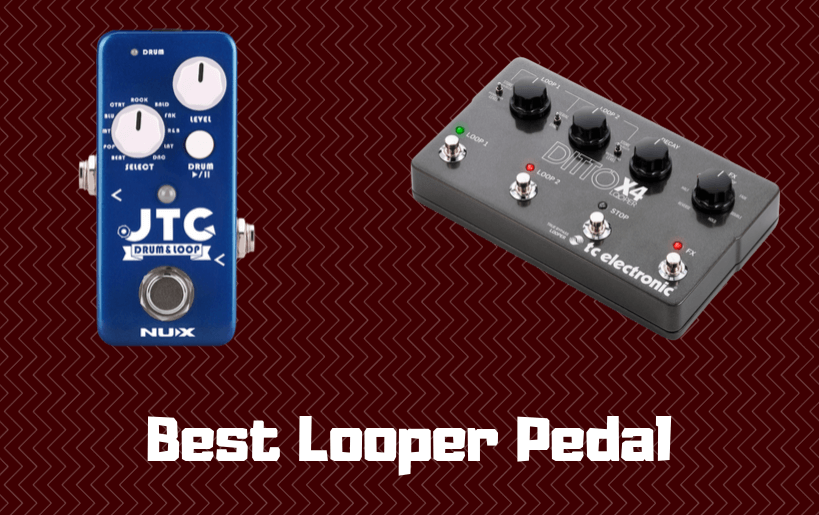
To help you with the quest of buying a looper pedal, I have gathered for you the 8 best looper pedals currently on the market. You can check out their advantages and drawbacks and decide which one fits better your playing. Read on!
Quick Navigation
Best Loop Pedals 2022 Summary:
Table could not be displayed.Top 8 Best Looper Pedals 2022 Reviewed
1. TC Electronic Ditto Looper Effects Pedal
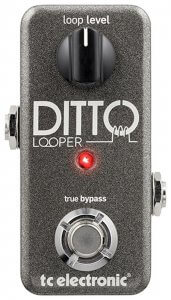
The TC Electronic Ditto Looper Effects Pedal is one of the most popular looper pedals, and that’s not only thanks to its low price. It comes in a compact size in order to fit easily in your pedalboard. It is extremely easy to learn and to use, as it comes with a single switch and a single knob. The switch toggles between play, record and overdub, while the knob allows you to control the volume.
The Ditto Looper offers up to 5 minutes of looping and unlimited overdubs, which is adequate for casual looping. It also has true bypass that won’t affect your sound when you don’t use it. It comes with a sleek design with grainy grey finish that allows it to fit everywhere. On the downside, it doesn’t operate on batteries and you need to purchase a power adapter, as it is not included in the package.
- Very easy to use
- Compact size
- Durable
- Affordable
- Doesn’t work on batteries and adapter is not included
2. BOSS RC-3 Loop Station
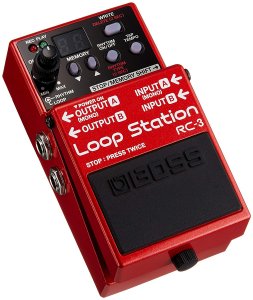
Boss is a very well-known guitar pedal brand and has a lot of experience in crafting looper pedals. The RC-3 packs a lot of features in a compact size, perfect for those with an already cramped pedalboard. Its built-in memory allows for 3 hours of recording time and provides you with 99 memory slots to store your loops. The USB 2.0 connection lets you export your loops in a computer or import sounds directly on the pedal.
The RC-3 comes also with an AUX input that allows you to connect external audio sources to the pedal. Extra features include tap tempo, a built-in drum machine and 9 pre-recorded loops to play along. Probably the only downside of this pedal is that it doesn’t have true bypass, which means that your guitar sound is slightly altered when the pedal is off.
- Hours of recording and storage
- Sturdy build quality
- Compact size
- USB connectivity and AUX input
- Doesn’t offer true bypass
3. Electro-Harmonix 720 Stereo Looper Pedal

The Electro-Harmonix 720 Stereo Looper Pedal is a pretty affordable pedal that can store up to 720 seconds (12 minutes) of loops. It offers 10 slots where you can store your musical ideas, which you can play in reverse or half-speed, a useful extra feature for demanding guitarists. It provides high-fidelity 24-bit stereo recording at 44.1 kHz and has a compact size that doesn’t take too much space.
It comes with two silent footswitches and stereo capability, which lets you either record stereo signals (such as synths), or connect two instruments simultaneously. What distinguishes this pedal from other looper pedals is the dedicated “stop” switch that makes it easy to use when you play live. It comes with a 9V power adapter that saves you some money from having to buy it separately.
- Affordable
- Stereo connection lets you record two instruments
- Easy to use on stage
- Power supply is included
- It takes some time to get used to how it works
You may also like our list of best phaser pedals, best bass distortion pedals, best boost pedals.
4. Nux Loop Core Guitar Pedal
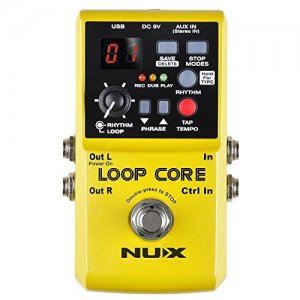
The Nux Loop Core Guitar Pedal is a budget-friendly looper pedal that despite its low price tag, offers a bunch of useful features. It allows you to record up to 6 hours of loops with unlimited layering, and it provides you with 99 memory slots to store and recall the loops easily. It comes with dual inputs and outputs to connect a stereo instrument or two different mono instruments simultaneously.
The Nux Loop Core includes 40 pre-recorded drum samples that you can play along with. The USB connectivity lets you export your loops to your computer or import sounds directly into the pedal. Extra features include an integrated drum machine, tempo changing and phrase switching without latency. This pedal has a very compact size that allows it to fit your pedalboard easily, and features sturdy build quality that will last for long.
- Bang for the buck
- Dual inputs and outputs
- Hours of recording time
- USB connectivity and useful extra features
- The power adaptor is not included
5. Digitech JMSXT Jamman Solo XT
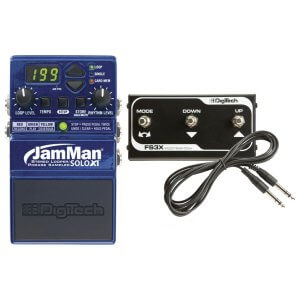
Digitech is a brand that has invested a lot in looper pedals and one of their best products is the Digitech JMSXT Jamman Solo XT. It is essentially a stereo looper pedal that allows you to record up to 35 minutes of audio and store it in 200 memory slots. The recording storage can also be expanded using an SD card. Extra features include the ability to slow down or speed up your loops using the tempo button, tap tempo function as well as an AUX input that lets you plug in external audio sources such as your MP3 player or phone. There are also 10 built-in drum loops to jam along. The Digitech JMSXT has a lightweight and compact design that makes it easy to carry around, in addition to fitting easily in your pedalboard.
- Great memory capabilities
- AUX input and tempo functions
- Compact size and lightweight design
- Power supply included
- Not very easy for live use
6. Pigtronix SPL Infinity Looper
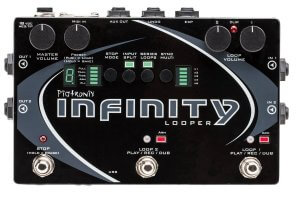
The Pigtronix SPL Infinity Looper is a guitar looper pedal that has been created to help guitarists with complex looping. The hours of looping that this pedal can record vary, based on your SD card capacity, and the pedal records 24-bit quality sound. What sets this pedal apart from other models is the ability to store two different loops, both in parallel and in series (one loop plays after the other).
The Sync Multi function lets you set the length of the second loop according to the first one. That can be especially useful if your playing is based a lot on looping or if you like to play live. The Pigtronix SPL offers dual inputs and outputs. MIDI in/out, AUX out and a USB port. The only drawback of this model is that it is quite pricey, compared to a basic looper pedal.
- High quality 24-bit sound
- Recording of two independent loops
- Lots of useful features (sync multi, MIDI)
- Versatility of inputs and outputs
- Expensive
7. Donner Tiny Looper Guitar Effect Pedal
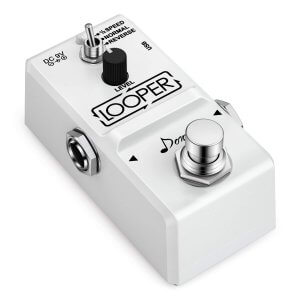
The Donner Tiny Looper Guitar Effect Pedal is a compact looper pedal, just as its name suggests. It has a minimalist design, fits every pedalboard and it has been built with portability in mind. It is pretty much as simple as it gets: it comes with a single input and output, a USB port, a footswitch, a volume knob, a three-way switch, and a power indicator LED. It is quite easy to use, especially for beginners. It offers ten minutes of recording time with unlimited layering, and it records high quality 24-bit/44.1 kHz sound.
The Donner Tiny Looper has true bypass technology that doesn’t alter your guitar sound when the pedal is off. The USB connectivity allows you to export your loops and import sounds from your computer. The build quality is robust and ensures that the pedal can withstand some abuse and it will last for a long time.
- Low price
- Easy to use – perfect for beginners
- Compact and portable
- True bypass
- Limited capabilities
8. VOX VLL1 Lil Looper Multi-Effect Pedal
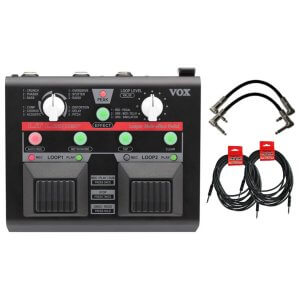
The final entry of this list comes from a well-known brand: the VOX VLL1 Lil Looper Multi-Effect Pedal is a premium-quality looper pedal that also incorporates 12 guitar effects such as reverb, chorus and distortion. It comes with two pedals and allows you to record up to 90 seconds of audio with each one and then add unlimited layers.
A very useful function of the Vox VLL1 is the loop quantize function that syncs your loops to the tempo as well as to each other. In addition to the instrument inputs, it includes an XLR input that lets you connect a microphone and make loops using your voice. The power supply is included and it can also run on AA batteries. The Vox VLL1 Lil Looper Multi-Effect Pedal comes in a low price considering its features and the fact that it comes with the power adapter.
- Value for money
- Two pedals and loop quantize function
- Comes with 12 built-in guitar effects
- Power supply is included
- It doesn’t come in a compact size
Having read about the pros and cons of all those premium-quality pedals, how do you pick one? Well, keep in mind that deciding on the right looper pedal for you is not only based on how much you are willing to pay. Of course, your budget plays an important role in your final decision, but you should also take into consideration a number of other factors.
To begin with, what are you planning to do with your looper pedal? If you like to play at home, maybe the USB connectivity will be important for you, in order to connect it with your computer. On the other hand, if you plan to play live, ease of use is crucial on stage. In addition to that, you should think about what you are planning to connect on the looper pedal: maybe you need that dual input to connect more than one instrument at once. And last but not least: how much space do you have on your pedalboard? Do you need a compact looper pedal?
Best Looper Pedal Buying Guide
Everybody can agree that looper pedals are fun: they allow us to play by ourselves and compose or play different parts of a song on the go. Looper pedals are especially useful in live settings, as well as rehearsals and practice. A lot of guitarists are looking to buy a looper pedal, but get lost in the specifications. Questions like “Should I get an analog or a digital pedal?” or “Do I need two independent loops?” start to arise when you are checking the multiple options available on the market. Here, I will guide you step-by-step to everything you need to know before buying a brand new looper pedal.
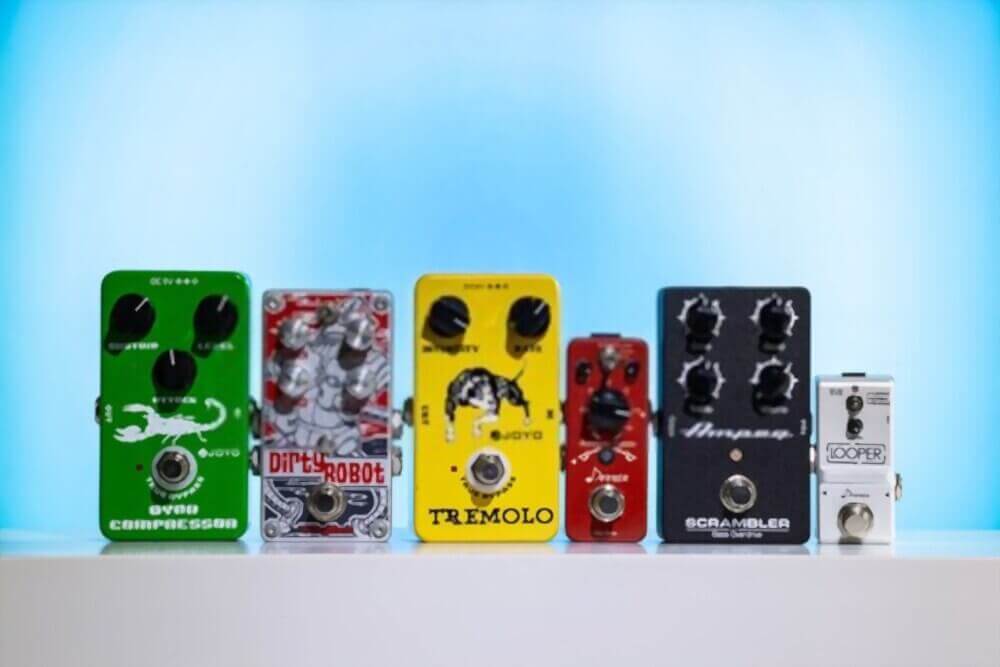
Sound quality
Looper pedals are part of your guitar sound, so their sound quality is quite important. If you have a pedalboard cramped with many different pedals, then you probably know that every pedal should have a “true bypass” function that allows the sound to pass through it without being altered when the pedal is off. This is also important for the looper pedal. Regarding digital pedals (that we will cover later), you should pay attention at the recording sound quality, that should meet 24-bit standards.
Analog or digital
The classic dilemma in music equipment today also applies to looper pedals. In my opinion, there is no clear option. It is true that analog pedals offer that warm analog sound that many musicians love, but on the other hand, digital pedals are more versatile and sometimes even cheaper. Before deciding which one is for you, try to keep an open mind and list the advantages and drawbacks of both options. Choose the one that will better fit your personal needs as a musician, according to your playing style and experimentation.
Ease of use
Who doesn’t want an easy-to-use pedal? There are many options for beginners on the market, and I would advise you to get a single knob/switch looper pedal if this is your first. Those pedals are very easy to learn, although you should keep in mind that operating a looper pedal correctly takes some practice. On the other side, if you are an advanced player and you are looking for something more complicated, then you might want something more “hard” to operate. Even in this case, keep in mind that if you plan to play a concert with the looper, it should be easy enough to use.
Size and build quality
Size can be an important factor in choosing a pedal if you have an already full pedalboard. However, keep in mind that sometimes compact size results in less versatile pedals that have stripped down features to keep their size small. Build quality is also something to take into consideration, as guitar pedals are often mistreated, either in live settings or while transporting them to different places. In this case, those that are not made from sheer plastic can last longer.
Inputs and outputs
Inputs and outputs define a lot of the capabilities of a looper pedal. Stereo inputs sometimes allow you to connect two instruments at once or connect a single stereo instrument. A few pedals also include an XLR input that lets you connect a dynamic microphone. Stereo outputs are also useful for stereo audio systems. There are certain models that come with an AUX input which lets you connect your MP3 player or phone directly to the pedal for play-along music. Many digital pedals also come with incorporated USB connectivity that allows you to export your loops to the computer, or import tracks and pre-recorded loops directly into the pedal. Some loopers even come with built-in MIDI connectivity for greater versatility and connection to a digital audio workstation.
Memory
Loopers work by storing musical phrases and playing them over and over. While most pedals allow for unlimited overdubbing (recording one loop on top of the other), there are different limitations of memory regarding the total length of the musical phrase they can hold. Most analog pedals can only record a single phrase, while digital pedals might come with different memory slots and many hours of memory to store. Sometimes, you can also expand the existing memory with an additional SD card.
Effects and other useful functions
There is a bunch of looper pedal models that do a lot more than casual looping. Certain pedals for example allow you to speed up or slow down your loops, while others let you quantize them. Many digital pedals come with pre-recorded drum samples to jam along to, and there are even some that incorporate a drum machine. There are also some pedals that make it easy to play live with a dedicated stop button or by letting you switch between different loops without latency.
Budget
Your budget is always a determining factor when you have to choose between different products. Fortunately, looper pedals can be quite inexpensive, so even those with a really low budget can get a decent one. However, you should keep in mind that most guitarists don’t change their looper pedal, so it is better to invest something more if you think that you will keep playing with it. Don’t forget the accessories: your pedal needs power to work, so you might need batteries or a power adapter. Power adapters can be quite expensive, so pay attention to whether they are included in the package
As you can see, looper pedals incorporate many different characteristics that allow for a great variety of models in the market. In order to choose the one that is appropriate for you, you have to think about the way that you intend to use your pedal. If you want to play live, you might need something that is quite easy to use and incorporates a stop button. On the other hand, if you want to experiment a lot, you should purchase a more complicated one with hours of memory and probably able to be connected to a computer. All in all, I hope that this guide has helped you choose your new looper pedal!
Whichever pedal you choose, you ‘d better get it quickly, as looping is a skill that takes some time to master. I wish you all the best of luck!